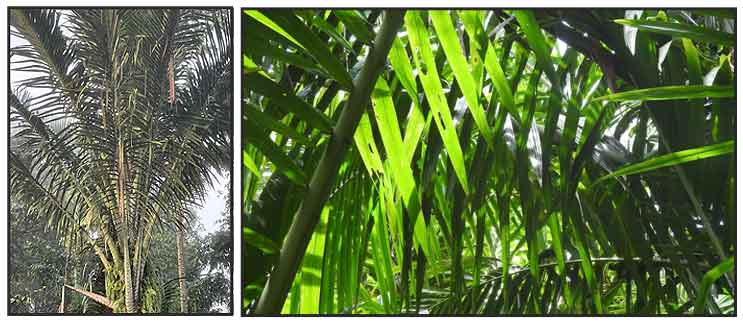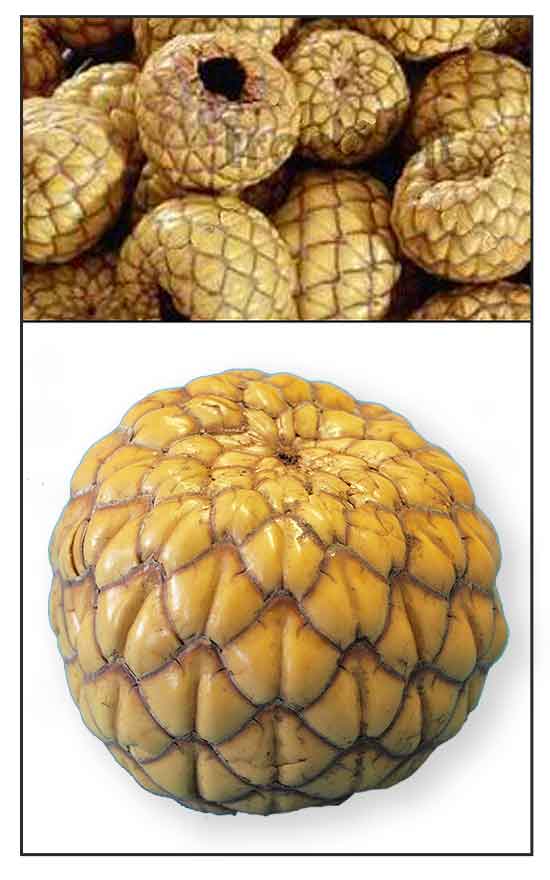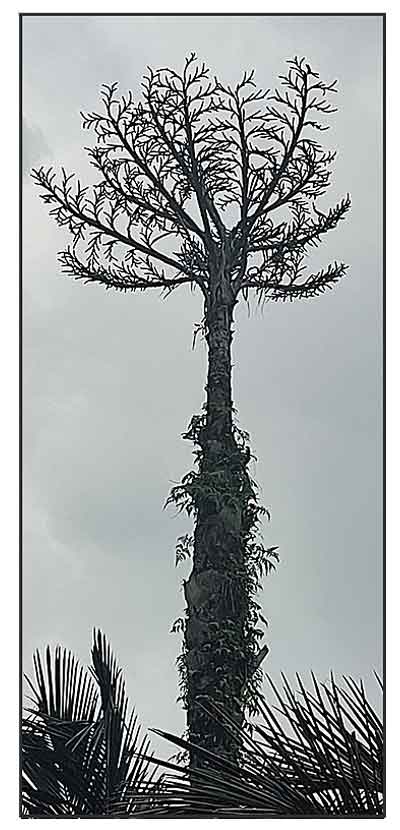 Gen info Gen info
- Metroxylon is a genus of monoecious flowering plants in the Arecaceae (palm) family, commonly called the sago palms, and consisting of seven species.
-
Sago is the most developed of the group of palms that provides a perennial source of staple crop. Sagos are multi-stemmed palms, and when cut down on maturity, it leaves behind an undamaged clump for future productivity. Trunks yield carbohydrates and fibers. Established after 5 to 7 years, a one hectare sago stand can yield 25 tons or more of edible starch indefinitely.
- S trunk cut just prior to flowering contains enough sago to feed a person for a year. (28)
- Etymology: The word sago is originally Javanese, meaning starch containing palm pith. In other languages, it has become a common name for various sources of starch or starch of any palm. (23) The genus name Metroxylon derives from Greek words metra, meaning "pith of the tree" or "parenchyma", (alternatively, meaning "womb", or "heart" in this context) and xylon, meaning "wood", referring to the large amount of internal pith. (13)
- Sago palm (Metroxylon sagu) is a promising crop with exceptionally high starch content compared to other starch-producing crops, with diverse applications in both food and non-food industries. Unfortunately, it is still undercultivated, the majority planted in small-scale sago farms in the semi-wild state.
(31)
Botany
• Sago is a palm tree of medium height, throwing up stems in succession, each stem in turn flowering, fruiting and dying after about 15 years. Leaves are pinnate, 6 to 9 meters long. Leaflets are linear-ensiform, up to 1.5 meters in length. Spadix is 3.5 to 4.5 meters long, the spathes quite spineless. Spikes are 10 to 12 centimeters long and about 1 centimeter in diameter. Fruits are globular, slightly depressed, with about 5 millimeters of pericarp, spongy and succulent mesocarp, and thin endocarp. Seeds are globular, depressed, with white, bony albumen.
 Sago palm is hapaxanthic, i.e., it flowers only once during its life; after fruiting, leaves senesce and the plant dies. (13) Sago palm is hapaxanthic, i.e., it flowers only once during its life; after fruiting, leaves senesce and the plant dies. (13)
• True sago palm is a suckering (multiple-stemmed) palm, each stem only flowering once (hapaxanthic) with a large upright terminal inflorescence. A stem grows 7–25 meters (23–82 feet) tall before it ends in an inflorescence. Before flowering, a stem bears about 20 pinnate leaves up to 10 m (33 ft) long. Each leaf has about 150–180 leaflets up to 175 centimeters (5+1⁄2 ft) long. The inflorescence, 3–7.5 m (10–24+1⁄2 ft) tall and wide, consists of the continuation of the stem and 15–30 upwardly-curving (first-order) branches spirally arranged on it. Each first-order branch has 15–25 rigid, distichously arranged second-order branches; each second-order branch has 10–12 rigid, distichously arranged third-order branches. Flower pairs are spirally arranged on the third-order branches, each pair consisting of one male and one hermaphrodite flower. Fruit is drupe-like, about 5 cm (2 in) in diameter, covered in scales which turn from bright green to straw-colored upon ripening. The sago palm reproduces by fruiting. Each stem (trunk) in a sago palm clump flowers and fruits at the end of its life, but the sago palm as an individual organism lives on through its suckers (shoots that are continuously branching off a stem at or below ground level). (28)
Distribution
- Naturalized.
-
Abounds in fresh-water swamps at low altitudes in Mindanao, and planted in some parts of Cebu, Bohol, Siquitor, Mindanao, Basilan and Sulu.
- Native to Fiji, Indonesia, Malaysia, Papua New Guinea, Singapore, Solomon Islands, Thailand. (13)
Constituents
- Contains 80% starch, 16% water, 2% nitrogenous substances, and very little ash.
- Nutrient analysis in (g) per bole and one leaf: N 590 (one bole) / 37 (one leaf), P 179 / 6, K 1799/20, Ca 860/90, Mg 350/7/ (19)
Properties
- Nutritive and easily digestible, free of any irritating properties.
- Studies have suggested antioxidant, antibacterial, immunomodulatory, antidiarrheal, wound healing, antifertility, adsorbent, postprandial glucose-lowering properties.
 Uses Uses
Edibility
- Nutritive, easily digestible.
- The upper portion of the trunk's core can be roasted for food. Yong nuts, fresh shoots and palm cabbage are also edible. (28)
- Sago is used in cooking puddings, noodles, and breads, as a thickener.
-
In the Sepik region of New Guinea, pancakes made from sago are a staple food, often served with fresh fish. (28)
- Sago grub is raised as by-product of sago starch production.
- In parts of Southeast Asia, the boles used to obtain starch. Hot water poured over slightly sour, wet starch is stirred into a glue-like mass eaten with fish and vegetable dishes.
- Palm heart and young leaves used as vegetable.
- Fully ripe fruit
astringent, but eaten as a delicacy by some. (27)
- Sago pearls used to prepare 'three palm pudding': sago pearls cooked in coconut milk, and topped off with sugar from sugar palm (Arenga pinnata). In Sarawak, pearls are prepared from sago palm starch, mixed with rice bran. (19)
Folkloric
- Food used during fevers and convalescence.
- In Malaya, recommended as an excipient in making poultices for shingles.
- In Papua, New Guinea, stem sap is applied to forehead to ease headaches. Starch from plant trunk mixed with water and drunk for diarrhea and stomach pains. Starch paste applied to burns. Leaf used to cover fresh or infected sores until they heal. Liquid starch given to newborns to treat enlarged spleen.
- In Sindh, a polyherbal formulation of polymenorrhea includes M. sagu: 3-4 sabudana (M. sagu), 3-4 choti ilaichi (E. cardamomum), and misri (crystal sugar), mixed and boiled in milk, taken half a glass twice daily for 5 to 6 days. For menorrhagia: soak zeera (Cuminum cyminum L.) and sabu-dana (Sago) (Metroxylon sagu Rottb.) in half glass water over night, taken orally in morning at fasting for 7 days.
- Used as traditional antifertiity medicine by Dayak people in Central Kalimantan.
- In South Kalimantan, fresh roots of sago traditionally used as antidiarrheal. (25)
 Others Others
- Poison: Fruit reportedly used as a poison in Malaya; the sap mixed with Datura by prisoners.
- Stabilizers: Sagu starch used in food production (high fructose syrup, MSG, maltodextrins, cyclodextrins); manufacture of paper coating, adhesives and biodegradable filler in bioplastics.
- Sago grub: Sagu grub raised as by-product of sago starch production, with stumps and stem tops left in the field for insect colonization. In parts of New Guinea, grubs are eaten in small quantities in the daily diet.
- Fodder: Ground pith sometimes used as animal feed, especially for pigs; when dried, for horses and chickens. Waste from starch extraction used as feed for hogs and other animals.
- Fiber: Processed pith yields a starch to produce fiber; leaves also yield a fiber used for making mats.
- Thatching and other uses: Fronds of palm used for thatching. In West Java, the palm is grown especially for leaf production. The rachis of fronds often used for walls. Bark used as floor material or fuel.(19) Leaflets used as thatching can remain intact for up to five years. Dried petioles (gaba-gaba in Indonesia) are used to make walls and ceilings; also used in construction of rafts. (28)
- Brooms: In the Philippines, rachis from fronds used for making walis-na-tingting.
- Grubs: In decaying trunks, grubs, especially Rhynchophorus spp., may grow, which are considered delicacy by all sago growers. Grubs are eaten fresh or roasted. They yield 6.9% protein, 8.5& carbohydrate, 11.3% fat, and 0.7% ash. (19)
- Fertilizer: Waste from pith processing used as fertilizer. (27)
- Construction: Bark used as flooring material. Hard outside of the trunk used for building purposes. (27) In the Philippines, the major use of sago palms is for roofing material. Leaves of small palms are cut and weaved in a 1-meter bamboo split. Sago shingles are more durable than nipa. The barks of petioles are stripped and woven into amacan (weaving mat) for walls of houses and cottages. Hard fiber bark are used for walls and floors, temporary passages for irrigating rice fields, and for firewood. (32)
- Fuel: Dextrose sugar extract from sago palm starch can be processed to yield ethanol. Cortex of the trunk used for firing in paper mills. Dried bark may be used as domestic fuel. (13)
Studies
• Glycemic and Insulinaemic Responses: Study investigated the effect of different forms of sago supplementation on plasma glucose and plasma insulin responses, as compared to white bread supplementation in man, during resting state. Results showed sago paste and porridge may be used for supplementation before and during exercise, and sago gel after endurance exercise during recovery process. (1)
• Inexpensive Lactic Acid from Sago Palm: Dulce Flores, a researcher from the University of the Philippines in Mindanao discovered a new streptococcus strain called Enterococcus faecium with the capability of converting sago starch directly into lactic acid without the costly pre-enzymatic treatment. Lactic acid is a colorless acid found in sour milk; used as a preservative in dyeing and in making adhesives and pharmaceuticals. (17)
• Antioxidant / Cigarette Smoke Exposure: Study showed Sagu aqueous extract supplementation has a protective effect in reducing free radicals released from sidestream cigarette smoke before causing extensive damage to the tissues. SAE supplementation might have a beneficial role in protecting smokers and non-smokers exposed to sidestream cigarette smoke. (4)
• Nitrogen Fixation: Study evaluated the presence and contribution of diazotrophic bacteria to nitrogen concentrations in sago palm starch. Nitrogen fixation were considered too low to be of nutritional benefit. Sago starch does not add significantly to protein calorie intake and may be associated with susceptibility to nutritional-associated illnesses. (9)
• Antibacterial / Skin and Wound Pathogens: Study evaluated the antibacterial activities of Thai medicinal plant formulas and their components against skin and wound pathogens. Except for E. coli and MDR E. coli, M. sagu demonstrated the strongest antibacterial activity on both gram-positive and gram-negative pathogens including MDR strains. (14)
• Antifertiity Effect: Study evaluated four plants viz. Metroxylon sagu, B. balsamifera, C. tigliu, and F. racemosa for antifertility effects on Swiss Webster mice. All the plant extracts antifertility effects, with the decrease in corpus luteum and fetuses attributed to inhibition of folliculogenesis. (15)
• Adsorbent for Oil Spills: Waste material generated by Malaysia's sago palm industry has potential for use as adsorbent for cleaning up oil spills. When sago waste is chemically modified using fatty acid derivatives, it becomes more hydrophobic, i.e., less affinity for water and an excellent affinity for oil. (16)
• Stabilizing Agent in Yoghurt: Yoghurt with 0.25% concentration of Metroxylon sagu contributes to firm body texture, decrease in whey separation, increase viscosity and increase in shelf life. (18)
• Latent Polyphenol Oxidases: Study reports on the extraction, partial purification and activation of latent polyphenol oxidase (LPPO), an enzyme responsible for the browning reaction of sago starches during processing and storage. The LPPO was highly reactive toward diphenols and triphenols. Enzyme activity was greatly enhanced in the presence of trypsin, SDS, ethanol, and linoleic acid. (21)
• Antioxidant / Decoction and Leaves: Study searching for natural antioxidants from Philippine medicinal plants evaluated decoction and ethanol extracts of leaves of Ficus nota, Metroxylon sagu, Mussaenda philippica, Inocarpus fagifer, and Cinnamomum mercadoi. M. sagu decoction (403.00 mg GAE, 96.39 AAE, 139.61 BHTE) and ethanol extract (310.58 mg GAE/g, 73.49 AAE, 102.36 BHTE) showed the second and third highest amount of phenolics, strong free radical scavenging against DPPH and high antioxidant capacities, respectively. (22)
• Immunomodulatory / Water Soluble Polysaccharides: Study investigated the immunomodulatory activity of water soluble polysaccharides isolated from M. sagu using three different in-vivo experimental models of immunosuppression in rats. The WSPS showed dose-dependent stimulation of immunity in the animal models. However, it was more efficacious against ethanol-induced immunosuppression. (24)
• Antibacterial / Antidiarrheal / Roots: Study investigated the antibacterial effect of sago root infusion in Salmonella typhi induced diarrhea and in male mice with castor oil induced diarrhea. Results showed antibacterial activity and reduction of frequency and duration of diarrhea. The best concentration of the infusion was 20%. (25)
• Silver Nanoparticles / Antibacterial: Study reports on a fast and simplified green synthesis method for the production of AgNPs via autoclaving. The synthesized AgNPs exhibited great antibacterial activities against Gm+ Micrococcus luteus and Gm- Escherichia coli. Results suggest potential application as antibacterial agent in various applications especially biomedical devices. (26)
• Modified Sago as Ingredient in Formulation of Low Glycemic Food Product: Native sago starch has a high content of resistant starch (RS) which is associated with low glycemic index and beneficial to individuals with obesity and diabetes. RS is linked to the prebiotic properties exhibited by starch. Study evaluated the predicted glycemic index (pGI) and probiotic growth rates of food formulated with native or modified starches in the formulation of a breakfast drink. Findings suggest the substitution of 50% wheat flour with native or modified sago starches is sufficient to increase the RS content and lower the pGI of formulated food. (29)
• Postprandial Glucose-Lowering Effects by Sago Resistant Starch in T2DM: There is evidence of beneficial effects of resistant starch consumption on reducing postprandial hyperglycemia. Study sought to identify the glucose lowering effects of Sarawak sago RS (native RS2 and chemically modified RS4) on Goto-Kakizaki rat. Studies involved in-vitro screening of α-glucosidase and dipeptidyl peptidase (DPP)-IV and histopathologic exams of pancreas, liver, and kidney tissues. Results suggest RS2 showed greater glucose-lowering effect than RS4, suggesting therapeutic potential and further exploration for T2D management. (30)
Availability
- Wild-crafted.
- Cultivatec. |

![]()



 Gen info
Gen info Sago palm is hapaxanthic, i.e., it flowers only once during its life; after fruiting, leaves senesce and the plant dies. (
Sago palm is hapaxanthic, i.e., it flowers only once during its life; after fruiting, leaves senesce and the plant dies. ( Uses
Uses
